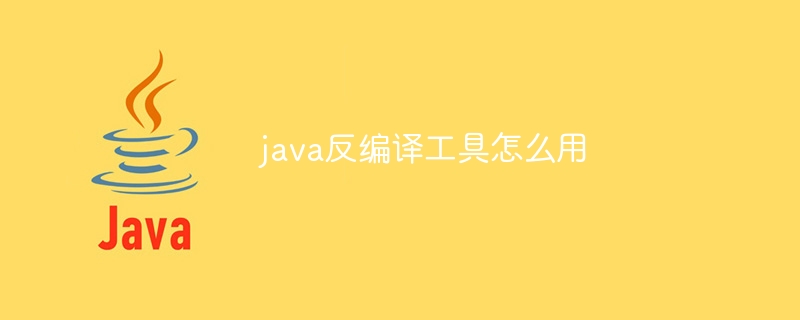How to use java decompilation tool
There are many decompilation tools to choose from, some of the more popular ones include JD-GUI, Procyon, Jadx, etc. For example, how to use JD-GUI: 1. Download and install JD-GUI: Go to the official website of JD-GUI to download the latest version of JD-GUI; 2. Run JD-GUI: use "java -jar jd-gui-x.y.z.jar " command to run JD-GUI; 3. Open the Java bytecode file; 4. View the decompiled Java source code.

Operating system for this tutorial: Windows 10 system, Dell G3 computer.
Java decompilation tools are usually used to decompile Java bytecode files into readable Java source code. There are many decompilation tools to choose from, some of the more popular ones include JD-GUI, Procyon, Jadx, etc. The following are simple steps to use JD-GUI:
1. Download and install JD-GUI:
Go to the official website of JD-GUI (https://github .com/java-decompiler/jd-gui/releases) to download the latest version of JD-GUI. Depending on your operating system, select the appropriate installation package (usually a JAR file).
2. Run JD-GUI:
Use the command line or double-click the JAR file to run JD-GUI. If it is a command line, you can use the following command:
java -jar jd-gui-x.y.z.jar
where x.y.z is the version number, replace it with the actual version number according to the downloaded file name.
3. Open the Java bytecode file:
Use the JD-GUI interface, click "File" -> "Open", and then select what you want to decompile A Java bytecode file (usually a file ending with .class).
4. View the decompiled Java source code:
JD-GUI will try to decompile the selected bytecode file and compile it in a format similar to the Java source code The form of the code is displayed on the interface. You can view classes, methods, and other structures in the JD-GUI window.
Please note that since decompilation is a reverse engineering operation, in some cases the original source code cannot be completely restored. In addition, when using decompilation tools, make sure you have the right to perform relevant reverse engineering operations to avoid violating legal regulations.
The above is the detailed content of How to use java decompilation tool. For more information, please follow other related articles on the PHP Chinese website!

Hot AI Tools

Undresser.AI Undress
AI-powered app for creating realistic nude photos

AI Clothes Remover
Online AI tool for removing clothes from photos.

Undress AI Tool
Undress images for free

Clothoff.io
AI clothes remover

AI Hentai Generator
Generate AI Hentai for free.

Hot Article

Hot Tools

Notepad++7.3.1
Easy-to-use and free code editor

SublimeText3 Chinese version
Chinese version, very easy to use

Zend Studio 13.0.1
Powerful PHP integrated development environment

Dreamweaver CS6
Visual web development tools

SublimeText3 Mac version
God-level code editing software (SublimeText3)

Hot Topics
 Square Root in Java
Aug 30, 2024 pm 04:26 PM
Square Root in Java
Aug 30, 2024 pm 04:26 PM
Guide to Square Root in Java. Here we discuss how Square Root works in Java with example and its code implementation respectively.
 Perfect Number in Java
Aug 30, 2024 pm 04:28 PM
Perfect Number in Java
Aug 30, 2024 pm 04:28 PM
Guide to Perfect Number in Java. Here we discuss the Definition, How to check Perfect number in Java?, examples with code implementation.
 Random Number Generator in Java
Aug 30, 2024 pm 04:27 PM
Random Number Generator in Java
Aug 30, 2024 pm 04:27 PM
Guide to Random Number Generator in Java. Here we discuss Functions in Java with examples and two different Generators with ther examples.
 Armstrong Number in Java
Aug 30, 2024 pm 04:26 PM
Armstrong Number in Java
Aug 30, 2024 pm 04:26 PM
Guide to the Armstrong Number in Java. Here we discuss an introduction to Armstrong's number in java along with some of the code.
 Weka in Java
Aug 30, 2024 pm 04:28 PM
Weka in Java
Aug 30, 2024 pm 04:28 PM
Guide to Weka in Java. Here we discuss the Introduction, how to use weka java, the type of platform, and advantages with examples.
 Smith Number in Java
Aug 30, 2024 pm 04:28 PM
Smith Number in Java
Aug 30, 2024 pm 04:28 PM
Guide to Smith Number in Java. Here we discuss the Definition, How to check smith number in Java? example with code implementation.
 Java Spring Interview Questions
Aug 30, 2024 pm 04:29 PM
Java Spring Interview Questions
Aug 30, 2024 pm 04:29 PM
In this article, we have kept the most asked Java Spring Interview Questions with their detailed answers. So that you can crack the interview.
 Break or return from Java 8 stream forEach?
Feb 07, 2025 pm 12:09 PM
Break or return from Java 8 stream forEach?
Feb 07, 2025 pm 12:09 PM
Java 8 introduces the Stream API, providing a powerful and expressive way to process data collections. However, a common question when using Stream is: How to break or return from a forEach operation? Traditional loops allow for early interruption or return, but Stream's forEach method does not directly support this method. This article will explain the reasons and explore alternative methods for implementing premature termination in Stream processing systems. Further reading: Java Stream API improvements Understand Stream forEach The forEach method is a terminal operation that performs one operation on each element in the Stream. Its design intention is






